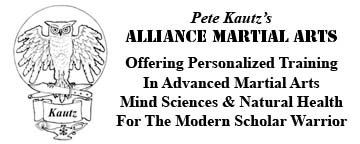|
|
Enter your e-mail address below and watch for a free weekly Training Tip on some aspect of martial arts, blade craft, conditioning, self defense, health, physical culture, history, mind training, attribute development, special offers & more |
What's New - Timeline - Articles - Techniques - Catalog - Seminars - Links - Contact Us
|
Volume I: Basics & Developmental Drills |
|
|
Volume II: Applications & Advanced Drills |
|
|
Volume III: Iron & Rattan Ring |
|
|
Volume IV: The Art Of Flow |
|
|
Complete Comtech Trapping Series Set:
4 DVDs (120) |
|
|
Wing Chun is a funny style because what you're doing at first doesn't always seem to relate to fighting in such an obvious way like when you learn Boxing. As a fellow student of the art, here are some ideas when first starting out. 1) Ask about your teacher about the specific lineage of what you're learning so you can get the correct books / videos as reference material for at home study. While everyone uses basic movements like Pak Sao roughly the same, there are a lot of different ways that you'll see the Siu Lim Tao and later sets performed and you want to be able to visually reference the exact same ones you'll be doing in class. Some styles, such as the version of Red Boat Wing Chun that Mr. Keating learned, don't even teach the solo forms but instead pass on the art through a series of clever two man exercises. 2) Don't worry about what anything is for as far as fighting goes. Just have fun, do it as you're shown, and everything will make sense once you start to do Chi Sao. It is in the practice of Chi Sao that you will become aware of what the implications of the various shapes are. 3) Pay attention to small details in learning. A good example is the basic stance with the hands chambered. In Karate this is done at the hips but in Wing Chun this is done at the ribs. But, if you put your fists at your ribs, there is a natural tendency for your elbows to stick out to the sides. (Try it right now and see.) Now, pinch those elbows together so the forearms are parallel at your sides and feel the effort between your shoulder blades this produces. The first position (elbows out) you could hold all day while the second one you can feel the power of the muscles involved, and this is part of the conditioning that the first form is meant to give you. 4) Do the form slowly to develop power and correct shapes. As you can see from the example above, just holding the positions correctly can be a power building workout. The first part of the form is done slowly anyhow, and taking 10 minutes to do the whole Siu Lim Tao is a good initial goal. Later try taking 15 or even 20 minutes to do the form; this can be quite taxing, more than one would expect. The traditional wisdom is that it's better to do the form once a day with Kung (work) where you are a little tired at the end than to do it for an hour as “flowery fists and brocade legs”, a term used to describe weak practice with no Kung. 5) Learn the Kuen Kuit, the traditional sayings of Wing Chun. These are a series of little sayings traditionally associated with Wing Chun. While some schools may have more or less of these, they are universally accepted as the Master Keys to understanding the shapes and concepts of the art. Learning them can put you ahead of more technically skilled players who don't understand the principles and are simply chasing techniques. The Kuen Kuit are fascinating “food for thought” and the longer you train in the art the more sense different ones will make. 6) Learn the names of all your movements in Chinese right from the beginning. Even if you don't use the traditional names at your school, by knowing the Chinese names of the blocks and strikes you will be able to converse clearly with Wing Chun players worldwide. For example, when I've gone to Germany a Lop Sao is still a Lop Sao, everyone understands. Also then should you watch videos out of China or work with Chinese who don't speak English, at least you will understand what movements they are talking about, if little else. All my very best to you, Pete Kautz
PS - Like this
Article? Sign up for the Training Tips at the top of the page and get
an original article like this sent to you by e-mail every week on Tuesday!
|
|
Check Back Next Week For A NEW
Special!
What Will It Be???
What's New - Timeline - Articles - Techniques - Catalog - Seminars - Links - Contact Us
